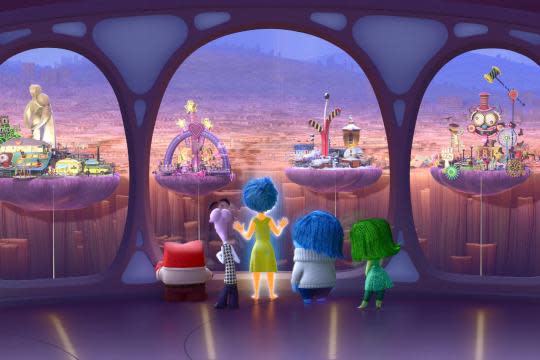Cannes Report: Pixar's 'Inside Out' Is a Delightful Movie to Have on Your Mind

‘Inside Out’ (AP Photo/Copyright Disney-Pixar)
Pixar hasn’t had an animated feature in two years, an absence that had the Cannes audience more than primed at the first screening of its new movie, Inside Out, on Monday (indeed, there was a hearty round of applause just for the studio’s logo). What followed did not disappoint: A brisk, delightful romp through the mind of an 11-year old girl that never stopped surprising with its inventiveness and emotional IQ. Directed by Pete Docter (Up, Monsters Inc.), Inside Out got a loud ovation at the end and some glowing reviews soon after.
The concepts behind Inside Out (which screened out of competition, and premieres in theaters June 16) are wildly challenging — especially for a film that’s ostensibly a kids’ movie. The film opens with the birth of a girl named Riley, who arrives with several newbie emotions already frolicking inside her head. First comes Joy (Amy Poehler), then Sadness (Phyllis Smith), Disgust (Mindy Kaling), Fear (Bill Hader), and Anger (Lewis Black), the five governing feelings who hang out in Riley’s Headquarters, and try to keep the complex machinery running.
Riley grows into a hockey-loving 11-year old girl (Kaitlyn Dias) who has a Joy-full childhood in Minnesota with her loving parents (Diane Lane and Kyle MacLachlan). That idyll is thrown into turmoil when the family moves to San Francisco, amusingly depicted as a noisy, smelly dump with crappy pizza. The emotions try to keep a homesick Riley righted, but when Joy and Sadness get marooned far from Headquarters with the all-important core memories, they have to make the perilous journey back before Riley’s world falls to pieces. (And the movie literally means “fall to pieces”: We see previously thriving islands in Riley’s mind, like “friendship” and “honesty,” crumble and collapse into a black chasm like a terrifying scene from Inception.)
What’s consistently fun is the crazily clever ways Doctor and Co. devise to anthropomorphize some very abstract concepts. Memories are like glowing glass orbs tinged with color-coded emotions. Joy and Sadness get stuck in the labyrinthine library of long-term memory, with its mile-high racks, where they run into Riley’s abandoned imaginary friend, Bing Bong (voiced touchingly by Richard Kind). He leads Joy and Sadness on a shortcut through a secure-looking bunker called Abstract Thought, where their physical forms steadily devolve like a Cubist painting. The movie is full of such imaginative locales: There’s the Dream Factory movie studio, the Train of Thought that stops running when Riley goes to sleep, and the Subconscious jail where the scary birthday party clown is kept incarcerated.
So where does Inside Out stack up in the Pixar canon? As witty and astute as it is, there’s nothing in Inside Out that matches the bravura opening sequences in Up or WALL*E, the breathtaking action-comedy of The Incredibles, or the mournful melancholy of Toy Story 3. It seems churlish to knock a movie for not being a masterpiece, though. Especially one that’s so in touch with its feelings.
Watch a clip from ‘Inside Out:’
